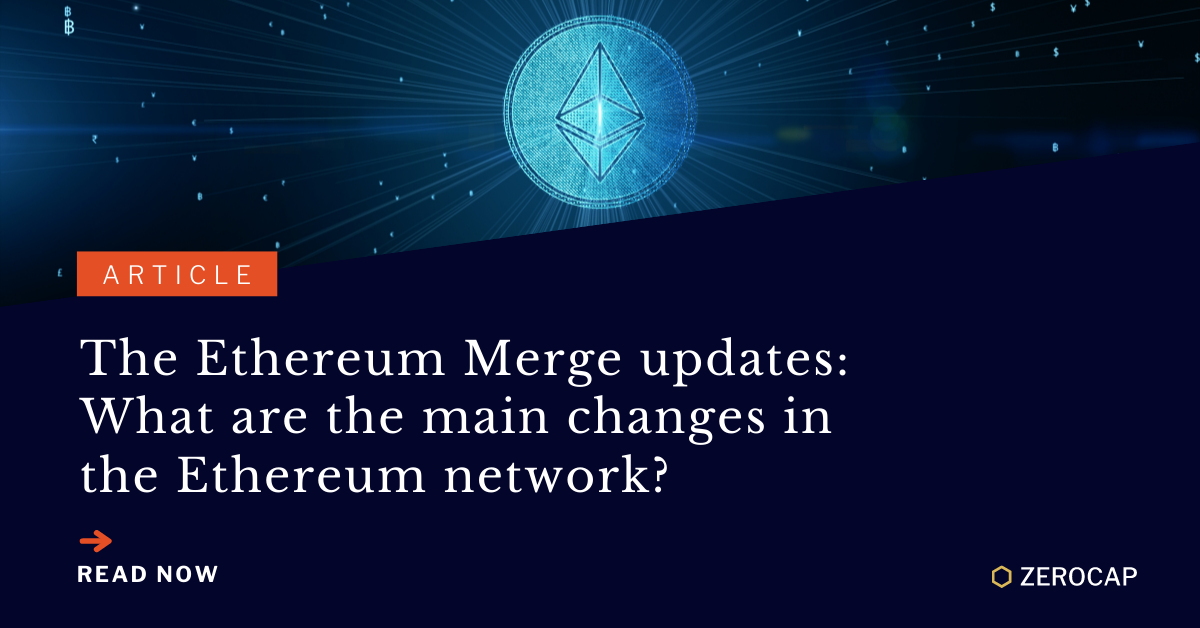Content
- Energy efficiency
- No more miners in Ethereum’s PoS network
- Cheaper, faster transactions? Not yet
- More decentralised
- Conclusion
- About Zerocap
- Disclaimer
- FAQs
- What is the Ethereum Merge and what does it mean for the Ethereum network?
- How does the Ethereum Merge improve energy efficiency?
- How does the Ethereum Merge affect miners and validators?
- Will the Ethereum Merge make transactions cheaper and faster?
- How does the Ethereum Merge contribute to Ethereum's decentralization?
15 Sep, 22
Ethereum Merge updates: What changes in the Ethereum network?

- Energy efficiency
- No more miners in Ethereum’s PoS network
- Cheaper, faster transactions? Not yet
- More decentralised
- Conclusion
- About Zerocap
- Disclaimer
- FAQs
- What is the Ethereum Merge and what does it mean for the Ethereum network?
- How does the Ethereum Merge improve energy efficiency?
- How does the Ethereum Merge affect miners and validators?
- Will the Ethereum Merge make transactions cheaper and faster?
- How does the Ethereum Merge contribute to Ethereum's decentralization?
The Ethereum Merge is finally here – officially moving the blockchain from a Proof of Work framework (PoW) to Proof of Stake (PoS), bringing many changes along for the new format.
In this article, Innovation Analyst Nathan Lenga covers the most important changes related to the Merge and how they affect the network, the ETH crypto asset and Layer 2s moving forward.
For another read on the Ethereum Merge, have a look at this previous article written by analyst Edward Goldman.

Energy efficiency
The main benefit of the merge, from a global perspective, is the substantial reduction in Ethereum’s unsustainable energy usage. The complaint that Ethereum consumes dangerously high amounts of energy to remain decentralised is frequently levied against the network. Before the Merge, Ethereum’s annualised energy consumption was 80.95 TWh, equivalent to the annual power consumption of the country of Chile. Furthermore, the Ethereum blockchain’s carbon footprint was 45.15 Mt CO2, which is comparable to the entire carbon footprint of Hong Kong. These issues arise due to the computational requirements needed to support the PoW blockchain, since miners validated blocks via the use of intense hardware energy.
Fortunately, the merge has rid Ethereum of PoW, potentially reducing the blockchain’s energy consumption by over 99.95%. With this, the annual energy expenditure for securing Ethereum is hoped to be brought down to 0.01 TWh. Therefore, the adoption and usage of the Ethereum blockchain can flourish, free from the chains of not being environmentally friendly. This factor might encourage more institutions, governments and legislators to focus on the benefits of a transparent, decentralised ledger, bringing more investors to the cryptocurrency ecosystem.
No more miners in Ethereum’s PoS network
Fundamental to the decentralisation and usability of the Ethereum PoW blockchain are miners. As such, Ethereum’s consensus mechanism no longer relies on miners, but rather validators after the merge. Whereas PoW required miners to utilise their computation power, Ethereum PoS simply needs validators to deposit their $ETH onto the Beacon Chain. Randomly, the Ethereum network will select a validator to propose the next block, with one’s likelihood of selection being proportional to their stake. Therefore, PoS can maintain the integrity and authenticity of the Ethereum blockchain via specific validators – proposing blocks randomly rather than miners fighting for the role of one block.
However, as miners leave the Ethereum blockchain, miner extractable value (MEV) becomes more difficult to obtain. MEV refers to the total value that can be extracted from blocks by miners who have the ability to reorder, insert and censor transactions to maximise their profit. Currently, the cumulative MEV extracted by miners is $675.1 million USD. Through leveraging their power to sequence these blocks, miners can earn additional value from transactions made via decentralised applications on Ethereum.
Since miners are no longer involved in Ethereum’s consensus and execution process, validators will begin searching for means to capture MEV. Given the possibility that validators with coding expertise utilise effective bots to search for and extract MEV, centralisation becomes a risk when few validators obtain a substantial stake. Nonetheless, a solution has been proposed within Flashbots’ MEV-Boost; to divide the roles of a validator into three parts. This includes a block builder who has the capacity to order transactions to maximise profit per block, a relayer that transmits the block to the proposer, and finally the unspecialised validator who proposes the block on the network.
Cheaper, faster transactions? Not yet
Although Ethereum lacks scalability in periods of high network activity, evident from gas fees with substantially high volatility, the merge does not advantage the speed or cost of transactions.
Notably, the merge changes the way Ethereum reaches consensus, not how the chain executes transactions. As such, the merge itself will not result in Ethereum gas prices reducing or the chain becoming more equipped to deal with the network activity levels experienced in bull markets. Ethereum PoW issues blocks, on average, every 13 or 14 seconds; this will be reduced to 12-second intervals between blocks after the merge. Despite the minimal increase in transaction time, most users will not notice the comparative difference.
However, the merge does begin the process of making Ethereum a monolithic blockchain. These chains allocate different tasks to separate layers. Ethereum’s scalability will come from Layer 2s compressing transactions into rollups and pushing them onto the mainnet to obtain Ethereum’s security and decentralisation. The merge prepares Ethereum for future innovations, including EIP-4844. This improvement to Ethereum introduces a new transaction type which adds 2 MB of space to each block. When combined with the compression methods utilised by Layer 2s, Ethereum’s scalability through these networks will hopefully increase by 10-100x. With this, transaction speeds and costs on Layer 2 networks are likely to fall significantly.
More decentralised
Although Ethereum is geographically distributed, the network’s decentralisation levels are limited by the exorbitant costs for mining rigs and energy costs. As of 2022, mining rigs for Ethereum can cost as much as $2k USD to obtain optimal hashing power. Moreover, energy costs can range from $0.20 USD to $0.50 USD per kWh. These costs clearly raise a high barrier of entry for miners. Therefore, due to the limits of additional individuals being involved in the validation of Ethereum, its decentralisation was inherently limited.
Contrastingly, after the merge, the costs of acting as a validator within the Ethereum blockchain was reduced significantly. As opposed to satisfying the price of a mining rig and satisfying the ongoing energy costs, validators must stake their $ETH on the Beacon Chain to earn a reward. Notably, in order for one individual to stake, they must deposit 32 $ETH. Despite the minimum entry requirement imposing higher costs on validators, this barrier can be overcome via validator pools, whereby many stakers’ $ETH are pooled together in lots of 32. This enables substantially more individuals to participate in the validation process for Ethereum transactions, ergo making the network more decentralised.
Conclusion
It is clear why the Ethereum Merge is the most important update in crypto’s history – a complete network change on the world’s biggest crypto ecosystem will rein in many benefits to Ethereum, its layers and digital assets as a whole. Opening the door to not only new opportunities and upgrades to the network in the future and its decentralisation, it forms a better dialogue between regulatory concerns regarding energy expenditure and the different blockchain frameworks that exists in cryptocurrencies.
About Zerocap
Zerocap is a market-leading investment bank for digital assets, providing unique investment products and technology to forward-thinking investors and institutions globally.
Disclaimer
THIS MATERIAL IS INTENDED FOR ILLUSTRATIVE PURPOSES AND GENERAL INFORMATION ONLY. IT DOES NOT CONSTITUTE FINANCIAL ADVICE NOR DOES IT TAKE INTO ACCOUNT YOUR INVESTMENT OBJECTIVES, FINANCIAL SITUATION OR PARTICULAR NEEDS. YOU SHOULD CONSIDER THE INFORMATION IN LIGHT OF YOUR OBJECTIVES, FINANCIAL SITUATION AND NEEDS BEFORE MAKING ANY DECISION ABOUT WHETHER TO ACQUIRE OR DISPOSE OF ANY DIGITAL ASSET. INVESTMENTS IN DIGITAL ASSETS CAN BE RISKY AND YOU MAY LOSE YOUR INVESTMENT. PAST PERFORMANCE IS NO INDICATION OF FUTURE PERFORMANCE.
FAQs
What is the Ethereum Merge and what does it mean for the Ethereum network?
The Ethereum Merge is a significant update to the Ethereum network that transitions it from a Proof of Work (PoW) framework to a Proof of Stake (PoS) framework. This change brings about many alterations to the network, including energy efficiency, changes in consensus mechanism, and potential for increased decentralization.
How does the Ethereum Merge improve energy efficiency?
The Ethereum Merge addresses the high energy consumption of the Ethereum network, which was a common criticism of the PoW framework. The Merge is expected to reduce Ethereum’s energy consumption by over 99.95%, bringing the annual energy expenditure for securing Ethereum down to 0.01 TWh. This makes the Ethereum blockchain more environmentally friendly, which could attract more investors and users.
How does the Ethereum Merge affect miners and validators?
With the transition to PoS, Ethereum’s consensus mechanism no longer relies on miners but on validators. Validators are chosen randomly to propose the next block based on their stake in the network. This change also affects Miner Extractable Value (MEV), the total value that miners could extract from blocks. With miners no longer involved, validators will begin looking for ways to capture MEV.
Will the Ethereum Merge make transactions cheaper and faster?
The Ethereum Merge itself does not directly improve the speed or cost of transactions. It changes the way Ethereum reaches consensus, not how it executes transactions. However, it does pave the way for future improvements that could increase Ethereum’s scalability, potentially reducing transaction costs and increasing speed on Layer 2 networks.
How does the Ethereum Merge contribute to Ethereum’s decentralization?
The Ethereum Merge lowers the barrier to entry for participating in the validation process of the Ethereum network. Instead of needing expensive mining rigs and high energy costs, validators simply need to stake their ETH on the Beacon Chain. This change, combined with the use of validator pools, allows more individuals to participate in the validation process, increasing the network’s decentralization.
Like this article? Share
Latest Insights
Interview with Ausbiz: How Trump’s Potential Presidency Could Shape the Crypto Market
Read more in a recent interview with Jon de Wet, CIO of Zerocap, on Ausbiz TV. 23 July 2024: The crypto market has always been
Weekly Crypto Market Wrap, 22nd July 2024
Download the PDF Zerocap is a market-leading digital asset firm, providing trading, liquidity and custody to forward-thinking institutions and investors globally. To learn more, contact
What are Crypto OTC Desks and Why Should I Use One?
Cryptocurrencies have gained massive popularity over the past decade, attracting individual and institutional investors, leading to the emergence of various trading platforms and services, including
Receive Our Insights
Subscribe to receive our publications in newsletter format — the best way to stay informed about crypto asset market trends and topics.



 Share
Share  Tweet
Tweet  Post
Post 